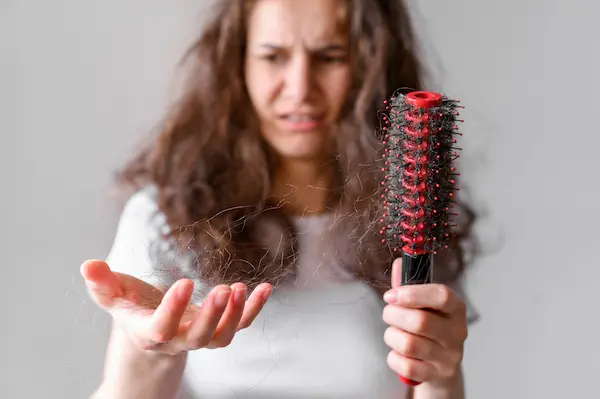Hair Loss Causes
At SkinSense Private GP Chelmsford, we understand the various hair loss causes affecting both men and women, including genetic factors, hormonal changes, stress, and medical conditions. Our expert team provides tailored solutions such as PRP therapy, mesotherapy, and supplements to address thinning hair, receding hairlines, and pattern baldness, helping you restore healthier, fuller hair with professional care.
Hair loss is more common in men than women, although some women do experience hair loss and hair thinning as a result of ageing. Hair loss includes receding hairline, thinning on the crown and temples, and can, in some cases, go to the extreme of complete balding.
There are 6 most common types of hair loss: male-pattern baldness, female-pattern baldness, alopecia areata, scarring alopecia, anagen effluvium, and telogen effluvium.

Male-pattern baldness
Male-pattern baldness, medically known as Androgenic Alopecia, is the most common type of hair loss, affecting around 50% of all men by the age of 50. Most men have some extent of hair loss by their thirties. The general pattern for male baldness is the receding hairline, followed by thinning on the crown leaving a horseshoe shape.
Male-pattern balding is most often hereditary, linking to having too much of a male hormone.
Female-pattern baldness
Female-pattern baldness is the same as male-pattern baldness, but affecting women. In this case, hair usually only thins on the top. It cannot be determined whether female-pattern baldness is hereditary, however it seems to occur more in women who have been through the menopause.
Alopecia areata
Alopecia areata is a condition which causes patches of baldness roughly the size of a coin. The most often occur on the scalp but can also occur on other parts of the body where there are hair follicles. This form of hair loss isn’t affected by age, but commonly occurs in teenagers and young adults. In most cases, the hair will grow back, but sometimes it can go on to develop into a more severe form of hair loss. The cause of Alopecia areata is problems with the immune system, and is therefore more common in those with autoimmune conditions, such as diabetes and overactive thyroid.
Scarring alopecia
Scarring alopecia, medically known as cicatricial alopecia, is a condition where the hair follicles are completely destroyed and will not grow back. It is usually caused by complications of another condition. Depending on the condition, the scalp where the hair has fallen out is likely to be affected in some way.
Scarring alopecia affects both men and women, and is more common in adults.
Anagen effluvium
Anagen effluvium is widespread hair loss that can affect the head and body. The most common cause of this type of hair loss is chemotherapy. In some cases, other cancer treatments such as radiotherapy may also cause hair loss.
The hair loss is usually noticeable in the first few weeks of the treatment, however not all chemotherapy drugs cause hair loss.In most cases, this type of hair loss is temporary and hair will grow back after stopping treatment.
Telogen effluvium
Telogen effluvium is a common type of alopecia where there is widespread thinning of the hair. The hair will feel thinner but you are unlikely to lose it all.
This form of hair loss may be caused by your body reacting to:
- Hormonal changes
- Emotional stress
- Physical stress e.g. childbirth
- Short term illness
- Long term illness
- Changes in diet
- Medications
Here at our Chelmsford clinic we have different hair loss treatments available to suit your needs, Mesotherapy, and hair supplements. We cover a wide area of Essex, including Braintree, Wickford, Basildon, Brentwood, and Billericay.
